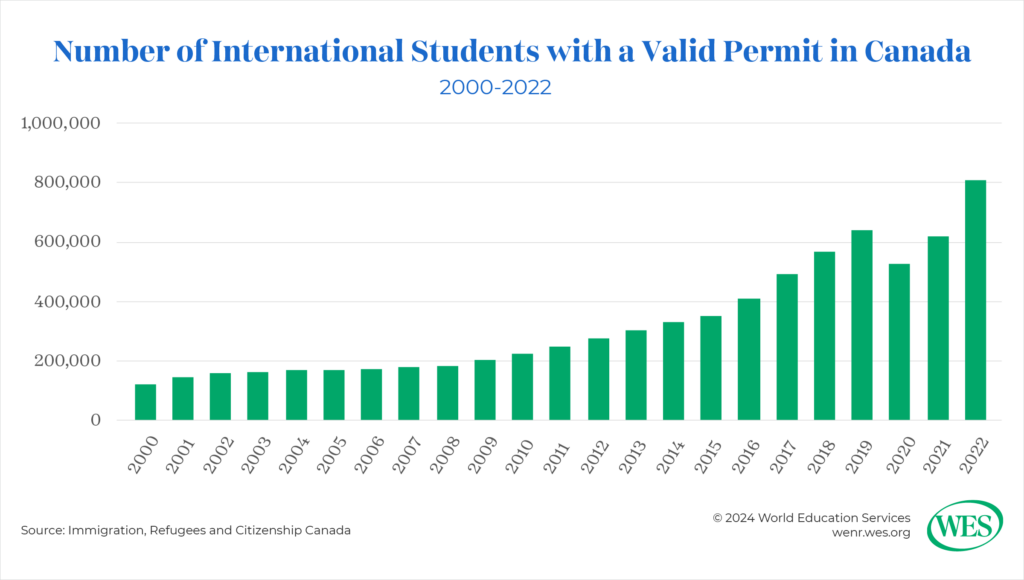Rasha Faek, Managing Editor, WENR

Canada has long been known for its welcoming stance towards international students, especially with its diverse and inclusive society, high-quality education system, and numerous student work opportunities. Still, recently introduced policies may signal an abrupt change in the country’s welcoming attitude.
Early this year, the federal government set out to implement a two-year cap on issuing new study permits for international students. This cap aims to control the influx of international students by limiting the number of study permits each province and territory can issue in 2024 and 2025. The new rule also requires that students obtain a provincial attestation letter (PAL) from the province or territory in which they hope to study, a change that suspends the issuance of new study permits until provinces and territories finalize PAL processes.
According to government officials, the aim of the cap, like those of a wave of recently adopted measures tightening restrictions over international students, is to protect international students and maintain the integrity of the nation’s immigration system. “Through the decisive measures announced today, we are striking the right balance for Canada and ensuring the integrity of our immigration system while setting students up for the success they hope for,” said Immigration Minister Marc Miller in a press release.
Still, experts and leaders in Canada’s international higher education sector expect the impact of these changes on international students to be immense. Even Canadian immigration officials expect the cap to reduce the number of new study permits issued in 2024 by 35 percent compared to the levels observed in 2023. According to the Canadian Bureau for International Education (CBIE), more than 1 million international students studied in Canada last year.
“Aspiring international students planning to study in Canada need to think twice now as these recent changes demand careful consideration before making any decisions, including exploring alternative options that may better suit your needs,” said Yash Sharma, Chief Executive Officer at Longshore Education, a consulting firm serving students in India who want to study abroad.
A Shift in the Overall Panorama
Canada’s permit cap comes amidst a rash of new policies tightening restrictions on international students. Just before the cap’s announcement, Immigration, Refugees and Citizenship Canada (IRCC), the department responsible for administering Canada’s federal immigration policy, raised minimum financial obligation for students applying for a study permit from C$10,000 to C$20,635.
The Canadian government has also introduced new restrictions on the ability of international students and their families to work while in Canada. These include barring international students enrolled in certain curriculum licensing programs at private colleges from eligibility for post-graduate work permits, as well as limiting open work permits for the spouses of international students to those whose partners are enrolled in a graduate-level program. Late last month, IRCC also allowed a policy that had permitted international students to work more than 20 hours per week to lapse.
Canada is not the only country making policy changes; Australia and the United Kingdom have also recently implemented alterations concerning international students. As of January 2024, the U.K. has revised its regulations to disallow dependents of international students from accompanying them on student visas, unless the students are enrolled in a postgraduate research program. Additionally, since July 17, 2023, international students in the U.K. have no longer been able to transition to a work pathway visa until after they fulfilled their educational requirements.
In parallel, Australia has introduced more stringent visa rules for international students in response to a notable rise in immigration. One noteworthy adjustment is the heightened English language criteria for obtaining student visas. Moreover, the new rules authorize the Australian government to restrict educational institutions from enrolling additional students if they violate the established rules and guidelines.
“The policies of countries that serve as major destinations for international students are transforming, which will inevitably reshape the landscape of student mobility. However, it will take some time for these changes to become apparent,” said Elsa Khalil, founder of Khalil Services, an international education consulting firm that operates in Canada, Lebanon, and the United Arab Emirates.
Khalil, who came to Canada as an international student many years ago, believes that Canadian measures are in the interest of the diversity for which the country has long been known. “The Canadian government recognizes the importance of fostering diversity within institutions, and by reducing the number of accepted students, academic institutions will have to ensure representation from different regions and markets to create a more inclusive and varied classroom environment,” she said.
Khalil also thinks that the government’s focus is on expanding opportunities for international students in cities beyond the traditional hubs like Montreal, Toronto, Ottawa, and Vancouver. She believes that the change “reflects their commitment to promoting growth and development across various provinces and cities in line with the IRCC’s mission.”
Time to Reflect
Isaac Garcia-Sitton, the executive director of International Student Enrollment, Education, and Inclusion at Toronto Metropolitan University believes that “the future of international education in Canada is at a critical juncture shaped by domestic concerns and global shifts, as major higher education providers like the U.K., Australia, and Canada reassess their international student policies.”
For him, the drivers underlying the policy changes are complex, ranging from shifting national sentiments on immigration to foundational issues like housing supply and the integration of international students into local communities.
Larissa Bezo, president and chief executive officer of CBIE, agrees that the public’s perception that temporary residents in Canada, particularly international students, are putting pressure on housing, infrastructure, healthcare, and social support systems is driving the government’s decisions.
“The federal government recognizes the need to address these challenges sustainably while keeping Canada open to temporary and permanent residents. They aim to create breathing room for communities and stakeholders to catch up and address the issues at hand. The recent announcements reflect these concerns and the ongoing dialogue surrounding them,” she said.
Still, she thinks it is essential to find a balanced approach that welcomes international students, as they are valued by our communities, institutions, and businesses.
“By convening a national dialogue and involving key stakeholders, we can better understand the value and potential of inbound international students. Moreover, we can explore ways to support their personal and professional goals while harnessing their talents for the benefit of Canada,” she said.
Meanwhile, Canadian institutions also acknowledge the need for regulations that ensure that international students have access to the support and resources they need.
“As a country that values international students and their well-being, it is important that we have policy measures in place to ensure that our systems are not being used to the detriment of vulnerable students and that our international students are adequately supported when they arrive in Canada,” said Garcia-Sitton. That said, he also acknowledges that these decisions pose challenges for Canadian universities and raise “concerns around the reputational impact of whether Canada will be able to maintain its position as a leading destination for international education.”
The cap could also exacerbate public institutions’ need for funding. “Without the additional revenue generated through international student fees, many institutions will not have sufficient financial resources to offer quality programming and support services for the students they enroll,” he said.
Still, to Garcia-Sitton, much depends on how the changes will be administered.
“Careful implementation of these policy measures could help meaningfully improve the experience of international students in Canada if these are supplemented with required financial support for educational institutions, more streamlined immigration support, and targeted transition programs.”
A Change of Plans

The cap, a temporary measure lasting two years, will not disrupt the usual renewal process for existing permits. However, the impact of permit caps will vary across the nation, as individual permit caps were set for each province and territory according to its population. Provinces where the permit cap surpasses recent study permit numbers may witness an increase in international enrollment. Others, like Ontario and British Columbia, where international student enrollment has grown rapidly in recent years, will experience the most significant effects as the issuance of new study permits decreases.
“The more significant challenge is the varying implementation of the cap in each province, which adds administrative complexities and confusion for students regarding the admissions process and study permit applications. There have been delays for some students due to the processing of applications being put on hold after the policy announcement,” said Bezo. Still, she hopes that this will not significantly dampen student interest. “As things settle, we anticipate progress and a continued positive response from institutions. Our sector is committed to providing high-quality education and supporting students holistically. We are actively working on robust frameworks, both on and off-campus, to address student needs and ensure their successful integration into our communities,” she said.
Canadian universities are trying to assess and mitigate any negative consequences of the new measure. “Our team is reviewing the new policy to determine its impact; however, we remain deeply committed to offering quality education and meaningful experiences for our students,” wrote Bashir Makhoul, the president and vice-chancellor of University Canada West in Vancouver, in an email.
Meanwhile, Toronto Metropolitan University, in consultation with universities, national associations, and sectoral groups, has been working closely with the provincial government in Ontario to streamline processes to accommodate the recent policy changes.
“Our student-facing teams in international recruitment and student support services are working diligently to stay informed of all the changes to assist students as they plan to begin their programs with us this fall. We have a team of Regulated International Student Immigration Advisors (RISIAs) and Regulated Canadian Immigration Consultants (RCICs) who are available for one-on-one sessions for international students to address their concerns and provide personalized immigration advice. We regularly schedule study permit information sessions and webinars to familiarize incoming students with the new process,” said Garcia-Sitton.
In turn, CBIE is planning to host a national dialogue on international students in Canada, bringing together education leaders, governments at all levels, the business community, and other stakeholders.
“There is always more that can be done, and while it’s a challenging transition, it presents an opportunity for us to collaborate as a sector and develop a more sustainable long-term perspective,” Bezo said. Over time, she is optimistic that “we will emerge stronger and more competitive, offering a sustainable solution. However, this process does come with its share of growing pains and short-term adjustments.”
However, considering the timing of the announcement and the temporary suspension of new permit applications, Garcia-Sitton acknowledges that some students may explore alternative study destinations, at least in the short term.
Out of the Bottleneck
Garcia-Sitton calls on international students who are reevaluating their study plans in Canada to remain adaptable and informed by looking beyond immediate policy shifts and evaluating the quality of education, the inclusivity of the campus culture, and the support services available for international students. “Canada is home to world-class institutions and is known for its welcoming communities and diverse cultures, which can greatly enrich your student journey,” he said.
He also encourages students to explore long-term prospects offered by their chosen destination and see how the country’s stance on international graduates, particularly in terms of work opportunities, aligns with their career goals. “Higher education is not just about obtaining a degree but building a foundation for your future,” Garcia-Sitton said, highlighting the recent extension of the post-graduation work permit (PGWP) for master’s students. Unlike many of the other policies introduced in recent months, the extension of the PGWP will expand work opportunities for certain international students, allowing graduates of master’s degree programs to apply for a three-year work permit. Previously, the duration of work permits for these graduates corresponded to the length of their study program.
Garcia-Sitton believes that this policy shift contributes to increasing Canada’s global competitiveness as a leading study destination, signaling to prospective international students that Canada values their contributions and is committed to their professional growth, which “is essential in today’s competitive international education landscape.”
Looking ahead, Bezo encourages students who want to join Canadian universities to not give up.
“We firmly believe in delivering an exceptional educational experience, especially as our institutions are enthusiastic about welcoming and supporting students and nurturing their success in their educational pursuits. Our communities are vibrant, with ample capacity to accommodate students. While we work through the details, we hope to have the honor of hosting students in the future, even if it requires a slightly adjusted timeline, surpassing their initial expectations,” she said.
#Canadian #Policy #Leave #International #Education #Leaders #Apprehensive










